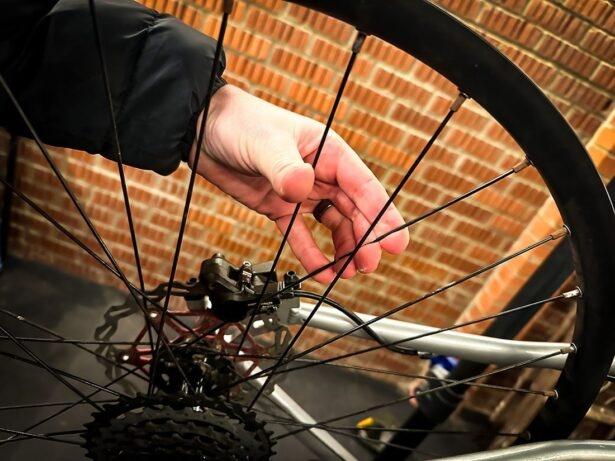Cycling is a very fun sport, and a good day out on the bike is a huge amount of fun. One thing that really helps when it comes to your cycling experience is keeping all your equipment in tip-top condition.
We get asked a lot of great questions from our readers about bike maintenance, and a question that comes up often is how to fix a bent rim.
Fixing a bent rim is quite challenging if you don’t know what you’re doing. In this article, we’ll tell you how to straighten a bent bike rim from your own home and ensure that your wheels will give you the best ride possible.
Disclaimer
This is a basic guide, and we only recommend doing this if you feel confident in working on your bike and have some experience. Although you might be doing the job properly, some wheels are past saving.
After completing this job, we recommend having it checked by a bike shop for safety.
Pre Work Checks
Before we start, it’s important to think about why your wheel might be bent in the first place. This might find the cause without having to work on the wheel and is going to go a long way in helping you fix the bend if it is bent.
The wheel might not be in the bike properly
Sometimes if you haven’t put the wheel back in the bike properly, it can make your wheel look bent. Ensure that it is in correctly so you don’t start adjusting your wheel without needing to.
Tire not seated
It’s not rare that people will end up in a bike shop thinking their wheel is broken when actually the tire just isn’t seated properly, and it is making the wheel look bent. Check the tire is properly seated before making any adjustments.
Broken Spoke
A very common wheel bending issue is a broken spoke. It’s important to check each spoke to ensure it is nice and tight and not hanging loose.
Wheel damage
The next thing to check is for any wheel damage. You might have a crack, or the hub could be damaged. Ensure everything looks in good condition, and it will also be worth making sure the wheel bearings are tight too.
Tools Required
- Spoke Key
- Bike Stand
- Cable Ties
Step One: Find the Bend
You will first need to find where the wheel is bent. If you have a truing stand, we recommend removing the wheel and putting it in.
If not, you will either want to get your bike in a stand or have it upside down. We personally recommend using a truing stand, but in this guide, we will do it with just a bike stand.
Once your bike is in the stand, you will want to get some cable ties on the chainstays to use as a reference to see the bend ensuring that they are nice and even on each side. You will be able to spin these cable ties to bring them closer and further from the wheel rim. Spin the wheel, and it will show you where the bend is.
Step Two: Locate the right spokes
Before adjusting spokes, it is vital to know how they adjust. Spokes will either come from the left or right of the hub.
If you want to straighten a wheel, you tighten the spoke, which will pull the rim straight again. For example, if the bend pushes the wheel out to the left, we tighten the spokes on the right.
 Now find the center of the bend by using the cable tie as your guide. Find the spokes which pull the rim in the right direction, typically on the opposite side of the hub, and then attach the spoke key to one in that area.
Now find the center of the bend by using the cable tie as your guide. Find the spokes which pull the rim in the right direction, typically on the opposite side of the hub, and then attach the spoke key to one in that area.
To check you have the right spokes try pulling them together with your hand, and the rim should straighten.
Step Three: Adjust the spokes
Now you have located the spokes that are out of true. You are going to start tightening them. You need to go clockwise to tighten and anti-clockwise to loosen.
You will only want to turn it a quarter turn each time and then spin the wheel to ensure you are pulling the rim in the right direction. You should and probably will need to do this across multiple spokes, not just one.
You will find yourself repeating this process over and over again until you are satisfied with how true the wheel is. It can be very challenging, and we recommend taking your time and only making little changes, and regularly checking that you are going in the right direction.
You really don’t need to adjust the spokes much to change the shape of a wheel completely.
Step Four: Destress the wheel
Now for the fun bit. When you are satisfied that the wheel is nice and true, you’re going to need to destress it. Remove the cable ties and take the bike for a very short ride.
You will generally hear the spokes pinging on the first few meters, and this is just them setting. After that check the wheel’s shape and ensure there are no funny noises. If there are any issues, get the bike back in the stand and start again.
Conclusion
We hope you enjoyed our guide on how to true a wheel. It is one of the more challenging tasks when it comes to bike maintenance, and if you don’t get it right and end up down the bike shop, don’t worry.
It’s not easy to master. With modern wheels being much stronger than older wheels, this isn’t something you will need to do often or ever.

Robbie Ferri has spent years working in a bike shop, has worked with industry leading brands on product creation, has been a semi pro athlete, and is a fully qualified strength and conditioning coach. He has broken World Records, bikepacked all over the World and raced ultra distance at a top-level.






